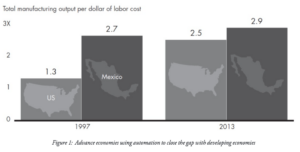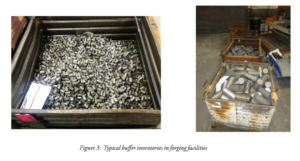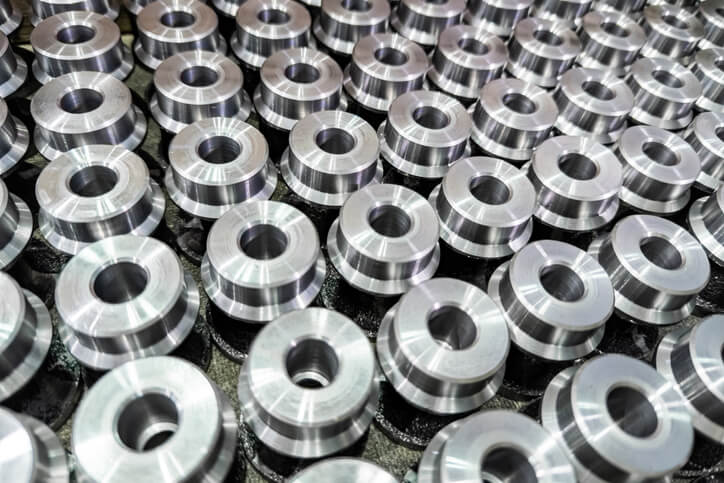By Jon Cocco
In September, I took a call from a new customer that was looking at setting up a new forging line in Texas. He wanted us to help with automating the feeding of billets into an induction heater for two press lines. While this is a common application for us, what was different in this discussion was the reason he needed the automation equipment. His company was moving production from China back to the United States. Over my 20 years of running global businesses, I have moved many production lines to low-cost countries to take advantage of the labor arbitrage. Now with the ever-growing sophistication of automation, I have been seeing a reshoring trend across many industries, including with our forging customers.
Push for Productivity
In just about every industry, production environments are changing drastically. The operational technology (OT) of manufacturing companies use automation to enhance their operation by increasing up-time and reducing overall labor costs — enabling companies to not only make processes more productive but also to give leadership and shop managers better quality and predictability of their equipment and output. Advanced economies are investing in automation to close the labor cost gap with emerging markets.
Twenty years ago, the manufacturing value added per dollar of labor was twice as high in Mexico vs. the U.S. By 2013, that gap had shrunk to less than 15% allowing the U.S. labor to be almost as competitive as Mexico (See Figure 1).

The trend of using automation to offset higher labor and shipping costs will continue to be the main lever for advanced economies to be competitive.
If you are involved in manufacturing, then you are very familiar with the “push for productivity” in your facilities. Productivity (i.e., output per labor hour) is the single best benchmark for operational efficiency used across a wide range of industries. The U.S. government publishes a quarterly measurement by the Bureau of Labor Statistics (BLS) that sets the baseline among companies. For the third quarter ending in October 2020, the labor productivity increased by 4.6% (non-farm payroll). Manufacturing sector labor productivity led the way, which increased at a remarkable 19.9% annual rate as output increased at a 56.2% annual rate and hours worked increased at a 30.3% annual rate². While this spike is making up for the downturn earlier in 2020, manufacturing will continue to lead the way forward. Automation-driven labor productivity by the manufacturing sector is predicted to reach over 55% over the next decade¹ and thus forging facilities need to keep up.
Forging Industry and Automation
For forgers, looking for ways to increase output for every labor hour is a constant demand to remain competitive in the industry without cutting the wage rates of existing employees. Specific automation solutions have been targeted by forgers and proven to increase their efficiency. This key component of a manufacturing or a production facility is the lean system by which numerous items and components are fed to other equipment, allowing the manufacturing process to move forward (See Figure 2).

Unless your facility is using an inline process from raw material to finishing, there will be buffer inventory between the processes (See Figure 3 for a familiar site among forgers).
In each of these inventory locations, the automation of part feeding and loading will dramatically increase the overall throughput of your operation and reduce inventory costs. A constant part feeding system is becoming an integral part of making this automation work and thus increasing productivity. Now more than ever, organizations looking to take their teams and facilities to the next level must not settle for parts feeding systems that do not support, align with, or enhance their production capabilities and goals.

Now is an ideal time for your business to invest in automation to make production more efficient. Businesses worldwide are continuing to emerge from the pandemic shutdown, and with demand beginning to pick back up, investing in automated parts solutions will ensure you are in the best position to maximize revenue — even if business is less than demand levels prior to the shutdown. Just as important, companies need to consider parts feeding solutions designed to operate at peak performance for extended periods of time. Production facilities are now operating 24 hours per day, seven days per week and 365 days a year to keep up with business and consumer demands. Such stringent expectations can take a heavy toll on equipment that is not designed or built to endure the rigors of this environment.
Three Considerations for a Truly Successful Parts Feeding System
What should your organization look for when it comes to parts feeding systems? Certain features and functionality should go without saying but remember how important parts feeding systems are to your overall production goals. You may be able to orient parts in a variety of different configurations, accept numerous loading options, and specify virtually any type of parts distribution, but if certain elements of your parts feeding system are not properly engineered, it will not be a successful solution for your business in the long run. Here are three things you should consider in order to turn your business into a world-class production facility and continue to meet your productivity targets.
1. Integration Flexibility
You need a system that works with your production environment. While there are systems available that can be readily obtained and not customized, that does not mean they are the right ones for your business. What matters is that your parts feeding system integrates with and supports the other equipment, IT infrastructure, and control systems in your facility. Obviously, parts feeding systems by their design support upstream processes in production, but consider what you really need to make the entire process turnkey and seamless. While Part Feeding Systems are typically the last item added to a process, the integration of this equipment is crucial to make everything work together. The controls package on capital equipment today is more complicated than ever before. With this sophistication, signals and switches can communicate between downstream processes to cue up more parts to feed. The integration of these software and hardware components provides greater flexibility and reduced downtime if they are planned out properly.
2. Reliability
Parts feeding systems play an integral role in both the manufacturing of the main throughput process in your operation, as well as the overall uptime of your facility. Automation is key to a successful production environment, but that automation must be reliable. The last thing your facility and team need to deal with is a machine repeatedly breaking down, becoming jammed, or failing in its intended purpose. These machines are long-term investments, which is why you want to work with a part feeding equipment provider that designs systems to operate continually with little ongoing maintenance. In evaluating the application of feeding parts into an induction heater, one of the most common methods to feed billets is to use vibratory bowls. However, in a survey conducted by Feedall Automation in 2018, U.S. forgers stated that the biggest issues with vibratory bowls were with maintenance and down-time (see Figure 4).

Therefore, when considering part feeders, you need to look at the reliability of the equipment and the total cost of ownership.
3. Flexibility and Quick Changeovers
Flexible automation allows manufacturers more versatility in creating products while minimizing downtime. They are highly adaptable systems with computer input and controls across the entire manufacturing process. Part feeders have become much more flexible to accommodate a wider range of part configurations with minimum changeovers. Flexible feeders are capable of processing multiple product types without retooling the entire machine. As system requirements and demands change, the flexible feeders have the adaptability to handle them. These feeders can manage changes to production schedules, demand patterns, and product mix changes with minimal changeovers.
Feedall Automation has been working with companies in the forging industry to solve their most complex and demanding production challenges. We offer a variety of parts feeding systems ranging from orienting feeders for both small and large parts to robotic bin picking systems that come in a number of different configurations to support your needs (see Figure 5). As more companies contemplate reshoring operations back in the U.S., this means finding unique solutions to remain competitive. Automation will continue to be the answer for most companies on how to capitalize on productivity enhancements and cost headwinds of the future. As I spoke with our customer from Texas on their new forging line in the U.S., he said this new turnkey automation made it possible to reshore this line and remain competitive with product coming in from China.
It’s clear to me that automation will continue to be a game-changer for companies to remain competitive and exceed their productivity targets.
References:
1) Labor 2030: The Collision of Demographics, Automation and Inequality, Bain Company: Karen Harris, Austin Kimson, Andrew Schwedel; 2018.
2) Non-farm labor productivity reported by the Bureau of Labor and Statistics December 9, 2020. www.bls.gov/news.release/prod2.nr0.htm
Author Jon Cocco is the owner and CEO of Feedall Automation in Cleveland, Ohio. He may be reached at jcocco@feedall.com or 440-942-8100 or you can follow him on LinkedIn at www.linkedin.com/in/joncocco/. For additional information, visit www.feedall.com.
